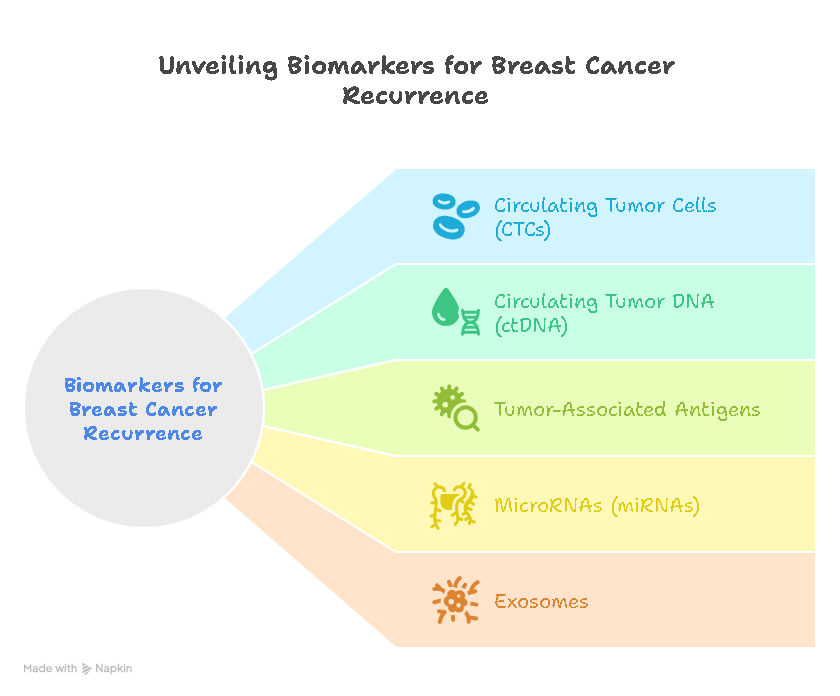This document explores the potential of using biomarkers for the early detection of breast cancer recurrence. Early detection is crucial for improving patient outcomes and survival rates. We will discuss various biomarkers, their roles in breast cancer recurrence, and the challenges and future directions in this field.

Introduction
Breast cancer is a leading cause of cancer-related deaths among women worldwide. While advancements in treatment have significantly improved survival rates, recurrence remains a significant concern. Recurrence can occur locally (in the breast or nearby lymph nodes) or distantly (in other parts of the body). Early detection of recurrence is critical because it allows for timely intervention and potentially more effective treatment strategies. Traditional methods for detecting recurrence, such as imaging techniques (mammography, MRI, CT scans) and physical examinations, often detect the disease at a later stage. Biomarkers offer the potential for earlier and more sensitive detection of recurrence, potentially leading to improved patient outcomes.
What are Biomarkers?
Biomarkers are measurable indicators of a biological state or condition. They can be molecules, genes, proteins, or other substances that are indicative of a particular disease or physiological process. In the context of breast cancer recurrence, biomarkers can be used to identify the presence of cancer cells, monitor treatment response, and predict the likelihood of recurrence.
Types of Biomarkers for Breast Cancer Recurrence
Several types of biomarkers are being investigated for their potential to detect breast cancer recurrence. These include:

Circulating Tumor Cells (CTCs)
CTCs are cancer cells that have detached from the primary tumor and are circulating in the bloodstream. The presence of CTCs is indicative of metastatic disease and can be used to predict recurrence. CTCs can be detected using various techniques, such as CellSearch and other microfluidic devices.
Advantages:
- Directly reflects the presence of cancer cells.
- Can be used to monitor treatment response.
Disadvantages:
- CTCs are rare in the bloodstream, making detection challenging.
- Standardization of detection methods is still needed.
Circulating Tumor DNA (ctDNA)
ctDNA consists of fragments of DNA that are released into the bloodstream by tumor cells. ctDNA can carry genetic mutations that are specific to the tumor, allowing for the detection of recurrence even before it is clinically evident. ctDNA analysis can be performed using techniques such as digital PCR and next-generation sequencing (NGS).
Advantages:
- Highly specific for tumor cells.
- Can detect recurrence at an early stage.
- Can be used to identify targetable mutations.
Disadvantages:
- ctDNA levels can be very low, requiring highly sensitive detection methods.
- Assay development and validation can be complex.

Tumor-Associated Antigens
Tumor-associated antigens are proteins that are expressed by cancer cells and can be detected in the bloodstream. Examples of tumor-associated antigens include CA 15-3, CEA, and HER2. These antigens are commonly used in clinical practice to monitor treatment and detect reoccurance.
Advantages:
- Relatively easy to measure in the bloodstream.
- Widely available and used in clinical practice.
Disadvantages:
- Can be elevated in non-cancerous conditions, leading to false-positive results.
- May not be sensitive enough to detect early recurrence.
MicroRNAs (miRNAs)
miRNAs are small non-coding RNA molecules that regulate gene expression. Aberrant miRNA expression has been implicated in breast cancer development and progression. Certain miRNAs have been identified as potential biomarkers for recurrence.
- Stable in the bloodstream.
- Can be measured using various techniques, such as quantitative PCR.
Disadvantages:
- The role of miRNAs in breast cancer recurrence is still being investigated.
- Standardization of miRNA assays is needed.
Exosomes

Exosomes are small vesicles that are secreted by cells and contain proteins, RNA, and other molecules. Exosomes can carry tumor-derived molecules that can be used to detect recurrence.
Advantages:
- Contain a variety of tumor-derived molecules.
- Can be isolated from various body fluids.
Disadvantages:
- Exosome isolation and characterization can be technically challenging.
- The role of exosomes in breast cancer recurrence is still being investigated.
DISCLAIMER: Dear Readers,
We, the authors, are seasoned medical practitioners with over 25 years of collective experience. The care tips and suggestions provided in this content are intended to offer general advice for promoting health. However, it is crucial to understand that every individual is unique, and what works for one person may not be suitable for another.
While our recommendations focus on natural and general care practices, we strongly advise you to consult with your family doctor or a qualified healthcare professional before incorporating any specific medications, chemicals, or advanced treatments into your care routine. Your family doctor can provide personalized advice based on your medical history, type, and potential sensitivities.
Our goal is to empower you with knowledge for healthier you, but individualized medical guidance is paramount for ensuring safe and effective care practices. Always prioritize your health and seek professional advice for any concerns.
Best regards,
dr.MAAS
director digital healthcare
COSMOCARE
preventadisease@gmail.com
powerofprevention@outlook.com

